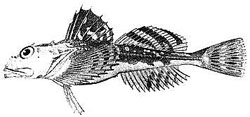
A sculpin is a type of fish that belongs to the superfamily Cottoidea in the order Scorpaeniformes. As of 2006, this superfamily contains 7 families, 94 genera, and 387 species.

The Cottidae are a family of fish in the superfamily Cottoidea, the sculpins. It is the largest sculpin family, with about 275 species in 70 genera. They are referred to simply as cottids to avoid confusion with sculpins of other families.
The Abyssocottinae are a subfamily of ray-finned fishes in the family Cottidae, the sculpins. They are known commonly as the deep-water sculpins. The entire family is endemic to Lake Baikal in Siberia.

Cottus is a genus of the mainly freshwater ray-finned fishes belonging to the family Cottidae, the typical sculpins. They are often referred to as the "freshwater sculpins", as they are the principal genus of sculpins to be found in fresh water. They are native to the Palearctic and Nearctic.

The mottled sculpin is a species of freshawater ray-finned fish belonging to the family Cottidae, the typical sculpins. This species has a wide but scattered North American distribution.
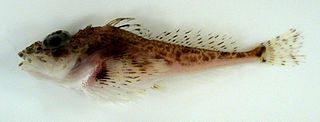
The scaled sculpins, Icelus, are a genus of marine ray-finned fishes belonging to the family Cottidae, the typical sculpins. Most of the fishes in this genus are found in the northern Pacific Ocean but they also occur in the North Atlantic Ocean.

The Pacific staghorn sculpin is a species of marine ray-finned fish belonging to the family Cottidae, the typical sculpins. This species is found in the eastern Pacific Ocean. It is the only species in the monospecific genus Lepidocottus.
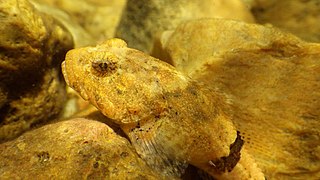
The banded sculpin is a freshwater fish dwelling mostly in small to moderate sized streams in areas of swift current. Young and juvenile C. carolinae can mainly be found in pools, riffles, and other shallow habitats while adults tend to prefer deeper waters. C. carolinae primarily eats insects and insect larvae, but their large mouths enable them to eat prey nearly as large as themselves, including other sculpin. To prevent predation, including by other fish, the color and pattern of the sculpin tends to match its environment. Most Cottus carolinae are mottled brown with dark vertical banding and usually reach about three inches in length. They have a broad head which rather quickly narrows into a slim body, giving them the appearance of a tadpole reaching adulthood.

Enophrys is a genus of marine ray-finned fishes belonging to the family Cottidae, the typical sculpins. These fishes are found in the northern and eastern Pacific Ocean.
Batrachocottus is a genus of freshwater ray-finned fishes belonging to the family Cottidae, the typical sculpins. These fishes are endemic to the Lake Baikal watershed in Russia.

The Blue Ridge sculpin is a species of sculpin in the family Cottidae. It is native to the eastern United States, where it can be found in a number of river systems that drain into the Atlantic.
The Cedar sculpin is a small, large-headed species of freshwater ray-finned fish belonging to the family Cottidae, the typical sculpins. This species is found in the Coeur d'Alene and St. Joe rivers in northern Idaho, and in a stretch of the Clark Fork river in western Montana. It is a common species of streams with cobble and gravel bottoms and cool to cold water.
The shorthead sculpin is a species of fish in the family Cottidae. Shorthead Sculpins are bottom-dwelling small fish, typically sizing around 13 to 15 cm long. They have large heads and fanlike pectoral fins. They have 7-9 dorsal spines, 15-19 dorsal soft rays, and 10-14 anal soft rays. Narrow caudal peduncle. Palatine teeth and coloration being dark brown and yellow.

Cottus duranii, the Dordogne sculpin or Chabot d’Auvergne, is a species of freshwater ray-finned fish belonging to the family Cottidae, the typical sculpins. It is found in France. It inhabits the Loire and Dordogne river drainages. It reaches a maximum length of 10.0 cm. It prefers streams with clear, cool, moderate to swift water and stone substrate. This species was described as a separate species from the European bullhead in 2005 by Jörg Freyhof, Maurice Kottelat and Arne W. Nolte. The specific name durani means “of Duranius”, the Latin name of the River Dordogne.
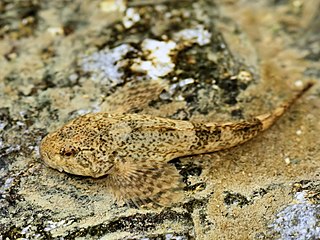
Cottus rhenanus is a species of freshwater ray-finned fish belonging to the family Cottidae, the typical sculpins. It is found in France, Belgium, Germany, Luxembourg, and the Netherlands. It inhabits the Rhine and Meuse river drainages. It reaches a maximum length of 10.0 cm. It prefers streams with clear, cool, moderate to swift water and stone substrate. Here, it mostly occurs in the shallow parts of streams. This species was described as a separate species from the European bullhead in 2005 by Jörg Freyhof, Maurice Kottelat and Arne W. Nolte. The specific name rhenatus means belonging to Rhenus, the Latin name of the River Rhine.

The inland riffle sculpin is a species of fish in the family Cottidae. It is found in the United States, inhabiting the lower Columbia River drainage in Washington, to Morro Bay in California. It is also found in the Puget Sound drainage in Washington. It reaches a maximum length of 11.0 cm. It prefers rocky riffles of headwaters and creeks.
The Ozark sculpin is a species of ray-finned fish belonging to the family Cottidae, the typical sculpins. It is endemic to Missouri,United States. Inhabiting the Osage, Gasconade, and Black river drainages in Missouri. It reaches a maximum length of 14.0 cm. It prefers rocky riffles of headwaters and creeks.
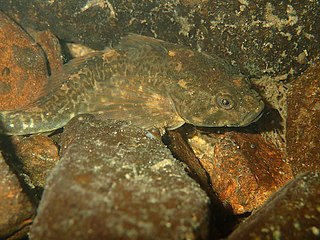
Cottus perifretum, the bullhead or miller’s thumb, is a species of freshwater ray-finned fish belonging to the family Cottidae, the typical sculpins. It is found on both sides of the English Channel, native to Great Britain. It also inhabits Atlantic drainages from the Garonne River to the Scheldt in France and Belgium, and the Moselle and Sieg in Germany. It is considered invasive in the Rhine drainage in Germany and the Netherlands. This invasive population in the Rhine is an intermediate between this species and Cottus rhenanus. Although this species is native to England and Wales it is considered to be a non-native invasive species in Scotland.
Cottus transsilvaniae is a species of freshwater ray-finned fish belonging to the family Cottidae, the typical sculpins. It is endemic to Romania in the upper Arges River in the Danube drainage. It reaches a maximum length of 9.7 cm. It prefers rocky shoals and riffles of small upland streams. his species was described as a separate species from the European bullhead in 2005 by Jörg Freyhof, Maurice Kottelat and Arne W. Nolte. The specific name transsilvaniae means “of Transsilvania”, the Latin name of the Transylvania.
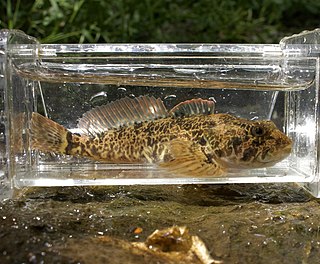
The coastal riffle sculpin is a species of freshwater ray-finned fish belonging to the family Cottidae, the typical sculpins. It is endemic to the Coast Range Mountains of California, where it is found in streams draining to the west and southwest. This taxon was considered to be conspecific with the inland riffle sculpin until research published in 2020 by Peter B. Moyle and Matthew A. Campbell showed that it was a separate valid species which was split into two subspecies. One, C.o. pomo, found in the northern Russian River and north San Francisco Bay drainage; and the other, C.o. ohlone, in the southern Santa Clara Valley. The specific name honors the Ohlone people, a Native American group which lived around southern San Francisco Bay and the Santa Clara Valley.













